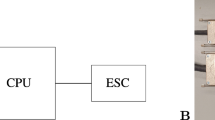Abstract
The two most important factors in improving performance in any software system, but especially a real-time, embedded system, are knowing which components are the low performers and knowing what can be done to improve their performance. The word performance with respect to a real-time, embedded system does not necessarily mean fast execution, which is the common definition when discussing non real-time systems. It also includes meeting all of the specified execution dead-lines and executing at the correct time without sacrificing non real-time performance. Using a Java prototype of an existing control system used on Deep Space 1[1], the effects from adding memory areas are measured and evaluated with respect to improving performance.
Access this chapter
Tax calculation will be finalised at checkout
Purchases are for personal use only
Preview
Unable to display preview. Download preview PDF.
Similar content being viewed by others
References
Rouquette, N., Neilson, T., Chen, G.: The 13th Technology of DS1. In: Proceedings of IEEE Aerospace Conference (1999)
Bollella, G., Gosling, J., Brosgol, B., Dibble, P., Furr, S., Turnbull, M.: The Real-Time Specification for Java. Addison-Wesley, Reading (2000)
Timesys Reference Implementation (2003), http://www.timesys.com/index.cfm?bdy=java_bdy_ri.cfm
Eclipse.org , http://www.eclipse.org/ (2003)
Headway Software (2003), http://www.headwaysoft.com/
Sitraka JProbe (2003), http://www.sitraka.com/software/jprobe/
Rinard, M., et al.: FLEX Compiler Infrastructure (2003), http://www.flex-compiler.lcs.mit.edu/
Corsaro, A., Schmidt, D.C.: Evaluating Real-Time Java Features and Performance for Real-time Embedded Systems. Technical Report 2002-001, University of California, Irvine (2002)
Deters, M., Cytron, R.K.: Automated Discovery of Scoped Memory Regions for Real-Time Java. In: Proceedings of the 2002 International Symposium on Memory Management, Berlin, Germany, June 2002, pp. 25–35. ACM, New York (2002)
Dibble, P.: Real-Time Java Platform Programming. Prentice-Hall, Englewood Cliffs (2002)
Author information
Authors and Affiliations
Editor information
Editors and Affiliations
Rights and permissions
Copyright information
© 2003 Springer-Verlag Berlin Heidelberg
About this paper
Cite this paper
Niessner, A.F., Benowitz, E.G. (2003). RTSJ Memory Areas and Their Affects on the Performance of a Flight-Like Attitude Control System. In: Meersman, R., Tari, Z. (eds) On The Move to Meaningful Internet Systems 2003: OTM 2003 Workshops. OTM 2003. Lecture Notes in Computer Science, vol 2889. Springer, Berlin, Heidelberg. https://doi.org/10.1007/978-3-540-39962-9_56
Download citation
DOI: https://doi.org/10.1007/978-3-540-39962-9_56
Publisher Name: Springer, Berlin, Heidelberg
Print ISBN: 978-3-540-20494-7
Online ISBN: 978-3-540-39962-9
eBook Packages: Springer Book Archive




